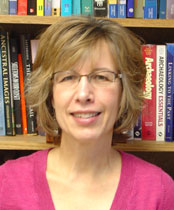2010-2011
Finding the Past: Prospecting in Archaeology
October 25, 2010
Rinita A. Dalan, Ph.D.
Professor of Anthropology and Earth Science, Minnesota State University Moorhead
Lecture:
Prospecting the Past: A Tale of Two Centers
Giffels Auditorium, Old Main
6:30 pm

Rinita A. Dalan is an interdisciplinary scholar whose pioneering research has focused on the integration of exploration geophysics and soil magnetism in the study of archaeological landscapes. She has had the great good fortune to work at the premier mound centers of Cahokia, Poverty Point, and the Hopewell Culture as well as numerous other sites in the U.S. and Belize. She has worked professionally since 1979 when she was first employed as an archaeologist and geophysicist at Geo-Recon International in Seattle, Washington. She earned a Ph.D. in ancient studies at the University of Minnesota in 1993 and is currently a professor of Anthropology and Earth Science at Minnesota State University Moorhead where she teaches courses in anthropology, geology, and geography and manages a state-of-the-art soil magnetic laboratory dedicated to archaeological applications.
Her work has been supported by grants from the National Science Foundation, the National Endowment for the Humanities, the National Park Service, the National Center for Preservation Technology and Training and others. She collaborated with Bartington Instruments (UK) on the development of a down-hole magnetic susceptibility sensor which she has broadly applied in her research She was the lead author of the book Envisioning Cahokia (NIU Press 2003) which was honored with an Illinois Museums and Historical Society Book of the Year award, and has authored and co-authored numerous articles on the development and use of new technologies, including those on the archaeological application of techniques of magnetic susceptibility (Archaeological Prospection 2008) and soil magnetism (Geoarchaeology 1998 and Geophysical Research Letters 1996), and geophysical methods for identifying buried sites (Archaeological Prospection 2006) and unmarked graves (Geoarchaeology 2010).
Acknowledgements
Funding provided by the Robert L. Stigler, Jr. Trust, the Digital Institute for Archaeology, the Archeo-Imaging Lab, and the J. William Fulbright College of Arts and Sciences.